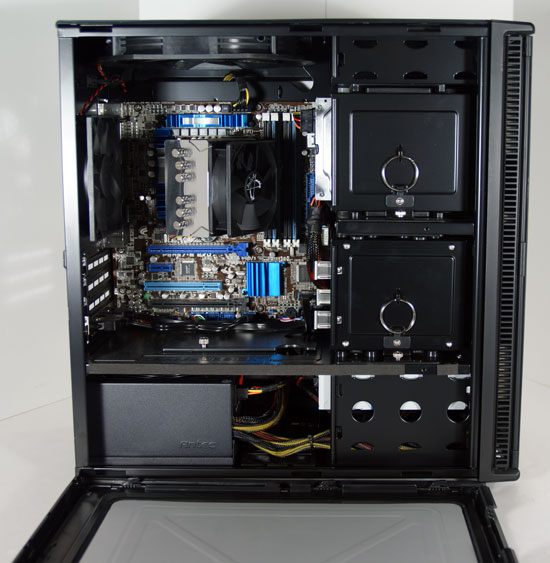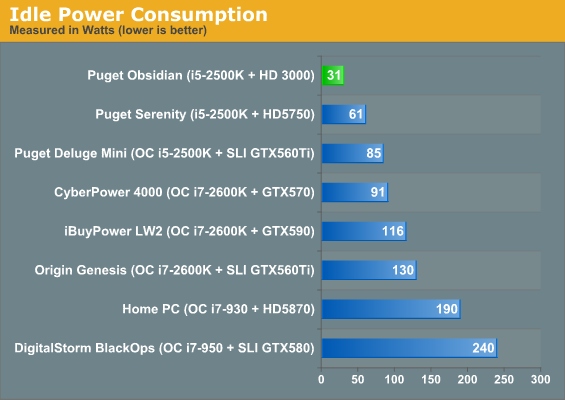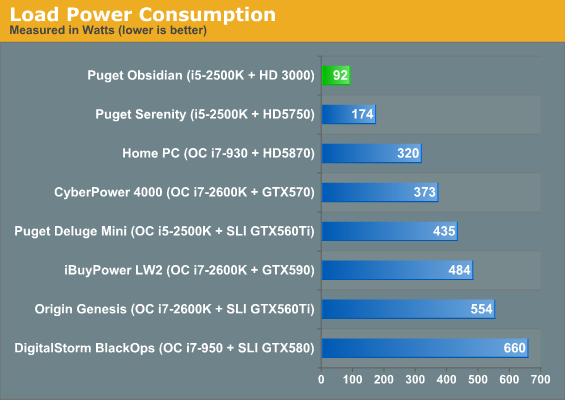Puget Systems Obsidian: Solid as a Rock
by Dustin Sklavos on April 7, 2011 6:15 PM EST- Posted in
- Systems
- Intel
- Puget Systems
Build, Noise, Heat, and Power Consumption
It's at this juncture that I really want to get into the meat and potatoes of how Puget Systems goes about selecting parts to offer in their Obsidian tower, because this is where they really shine. The build itself is solid, well made, and at least appears to use excellent hardware, but there's much more going on than is immediately obvious.
One of the keys with the Obsidian (and to a lesser extent the rest of Puget Systems' machines) is constant review and revision of the hardware available. The staff of Puget Systems meets weekly to go over existing support tickets and checks on every system that needs some form of repair or hardware replacement, looking for trends or bad batches of parts. Second is a tendency towards simplicity; you can't augment the Obsidian as much as you can other builds, and that's built on the basic principle that the less there is in the system, the less that can go wrong. Third, they have a tendency to lag the technology in this line behind some of the other ones to give extra lead time in case bad batches of parts do creep through and to ensure Obsidian systems are based on mature hardware. Finally, the Obsidian line has a unique service point that the other machines Puget Systems offers don't: they keep what you could basically call a hot spare on hand of every Obsidian they sell. If something goes wrong with one in the field, they have a backup immediately ready to replace it.

The funny thing is that I've really only scratched the surface of the kinds of reliability testing and checks and balances Puget Systems has for the Obsidian (much less their others). I've had the opportunity to actually take a look at some of their raw data, where they burn in hardware, do thermal imaging to check for hot spots, and keep track of failure rates. The end result of all of this testing is that their CEO Jon Bach claims (and I wouldn't be surprised if this were true) they've only ever had to actually advance replace two Obsidian towers in the three years the line has been available. Granted, there aren't nearly as many Obsidian systems in the wild as their are Dell Optiplex or HP Compaq business PCs, but large OEMs seem to focus at least as much on on-site repair and extended warranties as they do on overall reliability.
What we're left with on the Obsidian line is systems that are configured fairly modestly but are maximally reliable. As a result of these modest builds (overclocking isn't offered on this line for what should be obvious reasons) and smart component choices, it won't surprise you to see thermals are incredibly good.

Under heavy load the i5-2500K doesn't even hit 50C. To be fair, the processor is about the only part in the case short of the motherboard chipset generating heat, and Puget Systems has equipped it with the silent but effective Scythe Katana 3.


And under load, the Obsidian doesn't even pull 100 watts. At this point it's fair to suggest the Antec TruePower 650-watt power supply that ships standard with the Obsidian is complete overkill, but that power supply is actually the least expensive and least powerful one they offer in any build. Simplicity wins out here: system power draw at idle and load is impressively low. Puget's attention to detail is worth noting here, too: in our idle power their towers occupy the entire top of the chart. Even their overclocked SLI rig, the Deluge Mini, idles lower than CyberPower's Gamer Xtreme 4000...with a single card.
















27 Comments
View All Comments
Dustin Sklavos - Monday, April 11, 2011 - link
We're actually working on getting enterprise-class desktops in for review right now.robbster - Monday, April 11, 2011 - link
Have had occasion to use Puget for a couple of custom builds over the years for video/animation work and CAD. Their focus on quite machines that are uber-reliable is the key, and puts them in a special niche' that is attractive to folks in large businesses who also need a custom rig. The two builds I got worked very well and lasted a long time, with the exception of the hard drives, which were subject to the same risk of failure as all mechanical drives.Net, I agree that, if you're going to go with Puget for the quality and quite, then definitely equip the Obsidian with a SSD boot and larger RAID for data (using RAID-specific drives), to which you can backup the main drive as well. This is also how I build 'em for home, works great!
7Enigma - Tuesday, April 12, 2011 - link
So basically I can build this same exact system for much less and have Puget to thank for the R&D that went into the component selection. :) sounds like a win.Seriously though, they need some form of custom design in order to justify the price hike. I don't think you can compare this build to a Dell or HP as some of those vital components are total junk, the Puget uses quality gear. But without making a real need from a custom angle (sound dampening, ducting, etc.) and the pathetic warranty I just couldn't recommend this system to someone.
Thanks for the informative review.
yehuda - Tuesday, April 12, 2011 - link
With reliability being the primary selling point I'm surprised they did not use a server board and ECC memory. Do they not mind the risk of using consumer RAM in a business critical machine? Or maybe there's no practical risk? I'm genuinely curious.bobbozzo - Tuesday, April 12, 2011 - link
I don't know about Sandy Bridge systems, but many 'enthusiast' systems I have built over the years will run with ECC memory.yehuda - Tuesday, April 12, 2011 - link
No, not since the 975X I'm afraid. None of the enthusiast or mainstream platforms that followed supported it, and I really don't know how we should approach the subject nowadays, because personally I've always worried that a system without ECC memory is inherently unstable.Seeing as this build lauds reliability so much and yet Puget found it appropriate to ship 8 gigs of non-ECC memory to a very demanding sector, I'll be happy if they could share their reasoning.
spikespiegal - Monday, April 18, 2011 - link
So, Puget slaps together enthusiast parts and suddenly they are an HP / Dell contender? Yeah...OK. When you sell a million towers then you'll have some demographics to compare with a Dell precision.Failure rates of PCs are typically caused by component failure well outside the scope of what Puget claims they are testing; bad caps, faulty ICs, nominal voltage controllers, flaky HD controllers and motors, etc.
I'm trying to find an ASUS or Antec brand component in our data center and can't.
The low power consumption was due to the weak processor and lack of a dedicated video card. We have some dual core Thin Clients that use a fraction the power of the Puget and run on flash memory - no HD either. Would you like to benchmark those?